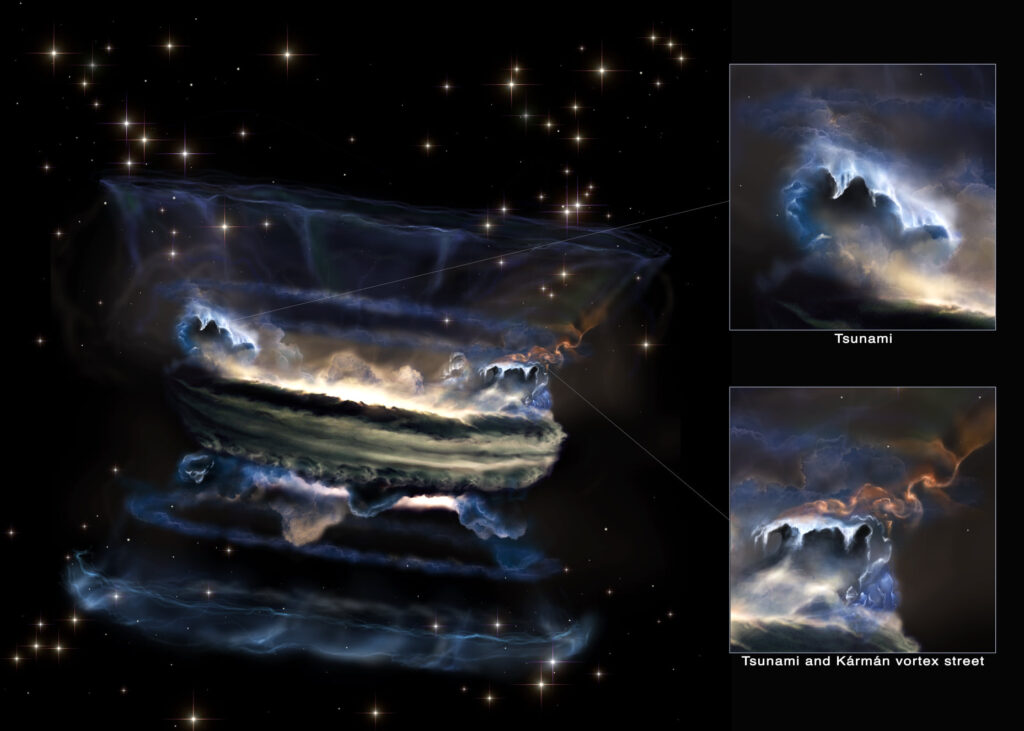Astrophysicists have used computer simulations to show that in deep in space, tsunami-like structures may form on much bigger scales than here on Earth, from gas escaping the gravitational pull of a supermassive black hole. In fact, the mysterious environment of supermassive black holes may host the largest tsunami-like structures in the universe, researchers say.
Black holes are mysterious by themselves. But for theoretical astrophysicists like Daniel Proga, a greater puzzle is solving the mathematical equations that describe how black holes distort their environments even dozens of light-years away.
When a black hole with a mass larger than a million Suns feeds off material from a surrounding disk at the center of a galaxy, the system is called an “active galactic nucleus.” Active galactic nuclei may additionally have relativistic jets at their poles and a thick shroud of material blocking our view of the central activity. But circulating plasma above the disk, just far enough that it won’t fall into the black hole, shines incredibly bright in X-rays —so bright that astronomers have been able to catalog over a million of these objects.

Strong winds, at least in part driven by this radiation, storm out of this central region in what’s called an “outflow.” Researchers want to understand the complicated interactions of gas with X-rays, and not just near the event horizon, where those X-rays are produced. The effects of these central X-rays can be important all the way out to tens of light-years from the black hole. In addition to launching outflows, X-ray irradiation may explain the presence of various populations of denser regions called clouds. Last year Proga and colleagues published simulations showing that more distant clouds can be produced within an outflow.
“These clouds are ten times hotter than the surface of the Sun and moving at the speed of the solar wind, so they are rather exotic objects that you would not want an airplane to fly through,” said lead author Tim Waters, a postdoctoral researcher at UNLV who is also a guest scientist at Los Alamos National Laboratory.
Now, the group has demonstrated for the first time just how complicated the clouds within these outflows from the central black hole engine really are. Their simulations show that just within the distance where the supermassive black hole loses its grip on the surrounding matter, the relatively cool atmosphere of the spinning disk can form waves, similar to the surface of the ocean. When interacting with hot winds, these waves can steepen into spiraling vortex structures that can reach a height of 10 light-years above the disk. That’s more than twice the distance from the Sun to its closest star, which is a little over 4 light-years. By the time tsunami-shaped clouds form, they are no longer influenced by the black hole’s gravity.

The simulations show how X-ray light coming from the plasma near the black hole first inflates pockets of heated gas within the atmosphere of the accretion disk beyond a certain distance from the active galactic nucleus. Heated plasma rises like a balloon, expanding into and disrupting the surrounding cooler gas. It can be scorching — hundreds of thousands to tens of millions of degrees, no matter which unit of measurement one might use.
Instead of a subsea volcanic eruption causing tsunamis, these hot pockets of gas in the outskirts of the accretion disk initiate the outward propagating disturbance. As the gas particles form a gigantic tsunami-like structure, it blocks the accretion disk wind, spawning a separate pattern of spiral structures known as a Kármán vortex street, with each vortex spanning a light-year in size. The phenomenon is named for physicist Theodore von Kármán, one of the founders of NASA’s Jet Propulsion Laboratory.
This all may sound exotic and far-flung, but Kármán vortex streets are common weather patterns on Earth that structural engineers must worry about, especially with regards to bridges.
The new results contradict a longstanding theory that the clouds in the vicinity of an active galactic nucleus form spontaneously out of hot gas through the action of a fluid instability. They also go against the idea that magnetic fields are needed to propel cooler gas from a disk into the wind. No satellite currently in orbit can hands down confirm the new findings. But NASA’s Chandra X-Ray Observatory and the European Space Agency’s XMM-Newton have detected plasma near active galactic nuclei with temperatures and velocities consistent with the simulations.
Stronger evidence may come from future missions. NASA’s forthcoming IXPE mission, launching in November, may contribute to scientists’ understanding of these phenomena. The X-Ray Imaging and Spectroscopy Mission (XRISM), a collaboration between NASA and the Japanese Space Agency (JAXA), could study these phenomena when it launches later this decade. The European Space Agency is also planning a mission called ATHENA, the Advanced Telescope for High-ENergy Astrophysics, which has this capability, too.
The origin of this article comes from www.nasa.gov.
